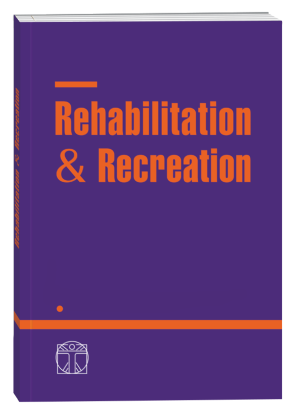BLOOD PRESSURE VARIATIONS THROUGH WATER WALKING EXERCISES AT DIFFERENT TEMPERATURE SETTINGS
DOI:
https://doi.org/10.32782/2522-1795.2024.18.4.2Keywords:
water walking, blood pressure, temperature, college students, exercise programAbstract
Background and Study Aim. Regular physical activity is crucial for cardiovascular health, and water walking is emerging as a beneficial exercise, though temperature effects on blood pressure are still not well-understood. Purpose. This study aims to examine the effects of water walking exercises at different water temperatures on blood pressure among college students, assessing which temperature range offers the most significant cardiovascular benefits. Material and Methods. Forty-five male college students from SRM Institute of Science and Technology, India, participated in a 6-week water walking intervention. Participants were randomly assigned to one of three groups, each exercising at different pool temperatures: 24–28°C, 28–32°C, and 32–36°C. Water walking sessions were conducted three times per week, and pre- and post-intervention blood pressure measurements (systolic and diastolic) were recorded. Statistical analyses included paired t-tests to evaluate within-group differences and ANOVA to assess between-group variations. Results. Notable decreases in systolic and diastolic blood pressure were recorded across all temperature groups. The 24–28°C group demonstrated the most substantial decrease in systolic pressure (mean reduction of 5.467 mmHg, t = 3.21, p < 0.01). ANOVA results showed a statistically significant effect of temperature on blood pressure reduction across groups (F = 4.37, p < 0.05), with cooler temperatures yielding greater reductions in both systolic and diastolic blood pressure. Conclusions. Water walking at cooler temperatures appears to enhance cardiovascular benefits, effectively reducing blood pressure among college students. These findings suggest that cooler water temperatures could optimize the health benefits of water-based exercise, offering a valuable intervention strategy for blood pressure management.
References
1. Igarashi, Y. (2023). Effects of differences in exercise programs with regular resistance training on resting blood pressure in hypertensive adults: A systematic review and meta-analysis. Journal of Strength and Conditioning Research, 37(1), 253–263. https://doi.org/10.1519/JSC.0000000000004236.
2. Edwards, J.J., Deenmamode, A.H.P., Griffiths, M., et al. (2023). Infographic. Exercise training and resting blood pressure: A largescale pairwise and network meta-analysis of randomised controlled trials. British Journal of Sports Medicine, 57, 1335–1336. https://doi.org/10.1136/bjsports-2023-107513.
3. Lee, S.Y., Im, S.H., Kim, B.R., & Han, E.Y. (2018). The effects of a motorized aquatic treadmill exercise program on muscle strength, cardiorespiratory fitness, and clinical function in subacute stroke patients: A randomized controlled pilot trial. American Journal of Physical Medicine & Rehabilitation, 97(8), 533–540. https://doi.org/10.1097/PHM.0000000000000920.
4. McGavock, J., Brunton, N., Klaprat, N., Swanson, A., Pancoe, D., Manley, E., Weerasinghe, A., Booth, G.L., Russell, K., Rosella, L., et al. (2019). Walking on water – A natural experiment of a population health intervention to promote physical activity after the winter holidays. International Journal of Environmental Research and Public Health, 16, 3627. https://doi.org/10.3390/ijerph16193627.
5. Chernyshev, V.V., Pryanichnikov, V.E., Arykantsev, V.V., Vershinina, I.P., & Kalinin, Y.V. (2019). Research of the walking type of movement in underwater conditions. In OCEANS 2019 – Marseille. Pp. 1–6. https://doi.org/10.1109/OCEANSE.2019.8867233.
6. Asami, T., Hotta, K., Ishii, Y., Sakai, W., Kojima, S., Morishita, S., & Tsubaki, A. (2020). Temperature and blood flow changes in the big toe skin of the stationary leg during single-leg pedaling exercises. Rigakuryoho Kagaku, 35(5), 693–698. https://doi.org/10.1589/rika.35.693.
7. Sanjaykumar, S., Rajkumar, N.C.J., & Lakshmi, P.Y. (2023). Impact of varied temperature living conditions, stress levels, and sleeping duration on oligomenorrhea: A comprehensive study among women. Physical Rehabilitation and Recreational Health Technologies, 8(4), 183–187. https://doi.org/10.15391/prrht.2023-8(4).02.
8. Kenney, W.L., Wolf, S.T., Dillon, G.A., Berry, C.W., & Alexander, L.M. (2021). Temperature regulation during exercise in the heat: Insights for the aging athlete. Journal of Science and Medicine in Sport, 24(8), 739–746. https://doi.org/10.1016/j.jsams.2020.12.007.
9. Peel, J.S., McNarry, M.A., Heffernan, S.M., Nevola, V.R., Kilduff, L.P., & Waldron, M. (2021). The effect of dietary supplements on endurance exercise performance and core temperature in hot environments: A metaanalysis and meta-regression. Sports Medicine, 51(11), 2351–2371. https://doi.org/10.1007/s40279-021-01500-2
10. Zhang, J., Liu, H., & Dai, W. (2023). Effects of exercise on human energy metabolism in high temperature and high humidity environment. Revista Brasileira de Medicina do Esporte, 29, Article e2022_0784. https://doi.org/10.1590/1517-8692202329012022_0784.
11. Farinha, C., Teixeira, A.M., Serrano, J., Santos, H., Campos, M.J., Oliveiros, B., Silva, F.M., Cascante-Rusenhack, M., Luís, P., & Ferreira, J.P. (2021). Impact of different aquatic exercise programs on body composition, functional fitness, and cognitive function of noninstitutionalized elderly adults: A randomized controlled trial. International Journal of Environmental Research and Public Health, 18, 8963. https://doi.org/10.3390/ijerph18178963.
12. Waffak, M.N., Sukoco, P., & Sugiyanto, F. (2022). The effect of water exercise and sand exercise training methods on agility in basketball athletes. Health, Sport, Rehabilitation, 8(2), 42–52. https://doi.org/10.34142/HSR.2022.08.02.04.
13. Moreira, N.B., da Silva, L.P., & Rodacki, A.L.F. (2020). Aquatic exercise improves functional capacity, perceptual aspects, and quality of life in older adults with musculoskeletal disorders and risk of falling: A randomized controlled trial. Experimental Gerontology, 142, 111135. https://doi.org/10.1016/j.exger.2020.111135.
14.Honório, S.A.A., Mendes, P.D.M., Batista, M., Serrano, J., Duarte, R.M., Oliveira, J., & Petrica, J. (2018). Effects of swimming and water walking on body composition and spirometric values in young children. NeuroRehabilitation, 43(2), 237–245. https://doi.org/10.3233/NRE-182422.
15. Bailly, M., Fillon, A., Bonjean, L., Lucas, D., Kabani, C., Chipon, S., Pereira, B., Duclos, M., Verney, J., & Thivel, D. (2022). Aqua walking as an appropriate and healthy winter and summer physical practice? An exploratory study. Healthcare, 10, 1258. https://doi.org/10.3390/healthcare10071258.
16. Palani, B., Raj, Y.C.L., Kalmykova, Y., Sanjaykumar, S., & Korsun, S. (2024). The effectiveness of a 12-week sport nutrition education intervention on female volleyball players performance. Physical Rehabilitation and Recreational Health Technologies, 9(3). https://doi.org/10.15391/prrht.2024-9(3).05.
17. Matsuda, T., & Akezaki, Y. (2017). Effects of aquatic walking exercise using a walker in a chronic stroke patient. Journal of Physical Therapy Science, 29(7), 1268–1271. https://doi.org/10.1589/jpts.29.1268.
18. Tanabe, N., Nishioka, Y., Imashiro, K., Hashimoto, H., Kimura, H., Taniguchi, Y., Nakai, K., Umemoto, Y., Kouda, K., Tajima, F., & Mikami, Y. (2023). Comparative study of muscle hardness during water-walking and land-walking using ultrasound real-time tissue elastography in healthy young people. Journal of Clinical Medicine, 12(4), 1660. https://doi.org/10.3390/jcm12041660.
19. Masumoto, K., Takasugi, S., Hotta, N., Fujishima, K., & Iwamoto, Y. (2004). Electromyographic analysis of walking in water in healthy humans. Journal of Physiological Anthropology and Applied Human Science, 23(4), 119–127. https://doi.org/10.2114/jpa.23.119.
20. Cugusi, L., Meloni, M., Bergamin, M., et al. (2023). Health effects of outdoor water sports in chronic disease: A scoping review. Sport Sciences for Health, 19, 1–15. https://doi.org/10.1007/s11332-022-00989-y.
21. Gallo-Silva, B., Cerezer-Silva, V., Ferreira, D.G., Sakabe, D.I., Kel-Souza, L.D., Bertholo, V.C., Brasil, M.T.F., & Moreno, M.A. (2024). Effect of water exercise on the respiratory function and functional capacity of patients with COPD: A randomized controlled trial. Fisioterapia em Movimento, 37, e37121. https://doi.org/10.1590/FM.2024.37121.
22. Green, D.J., Smith, K., Maslen, B.A., Cox, K.L., Lautenschlager, N.T., Pestell, C.F., Naylor, L.H., Ainslie, P.N., & Carter, H.H. (2021). The impact of 6-month land versus water walking on cerebrovascular function in the aging brain. Medicine & Science in Sports & Exercise, 53(10), 2093–2100. https://doi.org/10.1249/MSS.0000000000002685.
23. Li, D., Zhang, Q., Liu, X., Chen, C., Lu, J., Ye, D., Li, Y., Wang, W., & Shen, M. (2019). Effect of water-based walking exercise on rehabilitation of patients following ACL reconstruction: A prospective, randomised, single-blind clinical trial. Journal of Human Sport and Exercise, 14(Proc1), 47–58. https://doi.org/10.14198/jhse.2019.14.Proc1.07.
24. Naylor, L.H., Maslen, B.A., Cox, K.L., Spence, A.L., Robey, E., Haynes, A., Carter, H.H., Lautenschlager, N.T., Ridgers, N.D., Pestell, C., & Green, D.J. (2020). Land-versus water-walking interventions in older adults: Effects on body composition. Journal of Science and Medicine in Sport, 23(2), 164–170. https://doi.org/10.1016/j.jsams.2019.08.289.
25. Hurd, R.C., Belden, J., Bower, A.F., et al. (2019). Water walking as a new mode of free surface skipping. Scientific Reports, 9, 6042. https://doi.org/10.1038/s41598-019-42453-x.
26. Green, D.J., Silva, G.O., Smith, K.J., Maslen, B.A., Cox, K.L., Lautenschlager, N.T., Pestell, C.F., Ainslie, P.N., Haynes, A., & Naylor, L.H. (2024). Impact of water- and land-based exercise training on risk factors and vascular function in middle-aged and older men and women. Medicine & Science in Sports & Exercise, 56(2), 230–237. https://doi.org/10.1249/MSS.0000000000003302.
27. Skalski, D.W., Kreft, P., Czarnecki, D., Vynogradskyi, B., Kowalski, D., Zarichanska, L., & Kozachok, N. (2022). Aktywność fizyczna w środowisku wodnym. Rehabilitation and Recreation, 13, 140–146. https://doi.org/10.32782/2522-1795.2022.13.19.
28. Sivaraman, C., Rajkumar, N.C.J., Salini, B., Boby, F.A., & Sanjaykumar, S. (2024). A multivariate regression analysis of a comprehensiverehabilitationprogramandperformance improvement in young female volleyball players. Physical Rehabilitation and Recreational Health Technologies, 9(4). https://doi.org/10.15391/prrht.2024-9(4).01.
29. Sembaiyan, K., Krishnan, R.M., Sanjaykumar, S., Stadnyk, S., & Okun, D. (2024). Integrative approach of plyometrics and nutritional strategies on vertical jump performance in elite targetball players. Physical Rehabilitation and Recreational Health Technologies, 9(5), 385. https://doi.org/10.15391/prrht.2024-9(5).05.
Downloads
Published
How to Cite
Issue
Section
License

This work is licensed under a Creative Commons Attribution-NonCommercial-NoDerivatives 4.0 International License.












